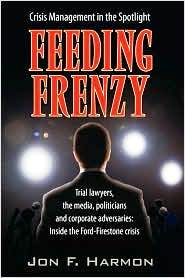This is a cautionary tale about how two old-line industrial companies were caught out in a global media crisis that badly tarnished the reputations of both. By the time that trial lawyers, politicians and the media moved on to other matters (prompted by the contested Bush presidential election in Florida that went all the way to the Supreme Court), Ford Motor Company and Firestone were shaken to their engineering roots and their business practices drastically altered — for a time, at least.
Feeding Frenzy-Trial lawyers, the media, politicians and corporate adversaries: Inside the Ford-Firestone crisis, by Jon Harmon, is a well-written first-hand account of the Firestone tire Recall and the Ford Explorer, which used a majority of the defective tires.
And, before you read further, be aware that Jon and I worked together at Ford on the crisis. It was the most challenging time of my life as a communicator, as a bureaucratic and opportunistic corporate culture was confronted with much faster moving and unethical adversaries, notably trial lawyers and their water carriers in the media. So beware of book reviews by friends of the author.
It is not that Jon needs a friend to review this book, though. It stands alone quite well as an inside view of the crisis, while serving as an entertaining platform for Jon’s strongly held, battle tested, beliefs on corporate crisis management. Read as such, it is worth the time. See Jon’s site by clicking here.
The real human tragedy behind this crisis is that more than 370 people are dead, and countless others seriously injured.
Why?
The answer is distressingly simple, though the causes are complex and arguable:
- The Ford Explorer sport utility vehicle of the period, like other sport utility vehicles then without electronic chassis controls, could roll over if driver control was lost.
- Compounding this inherent design problem of this high center of gravity vehicle was a marketing success story. It was the best selling SUV ever. The Explorer had become tremendously popular, with two plants working overtime for years to keep up with demand. Millions of them were on the road, with hundreds of thousands added annually when the scandal came to widespread public attention. Even this might have been okay, if a third decisive factor had not appeared.
- Ford had asked Firestone to supply a tire that looked like a “tough truck” tire with its blocky tread, but wanted it built for reasons of cost and comfort on a passenger tire carcass. As the tires aged, the tread separated from the tire because of design and manufacturing defects leaving an inflated shell. In effect, the driver was confronted with a yawing motion with the Explorer behaving as if it was suddenly on glare ice. Not all of the drivers or their passengers survived such incidents.
I will not enter into the debate here about how to weigh all the factors above or many others. I will say that Jon’s book is reasonably accurate and lively. If it has a fault, it is because Jon (and I) did not have access to the debates over the crisis at the Board of Directors level; and we were often ignorant of the behind-the-scenes maneuvering by executives looking to advance their careers at the expense of others, while others ran for cover.
These issues are complicated enough given the billions of dollars at stake in product liability actions, but there remains an even more sensitive issue. The Ford and Firestone families had inter-married decades ago, and two Ford family members sat on the Ford Motor board as the crisis became public. In addition, the family, through the financial engineering of a Class B stock, controlled the company even though it held only a small stake. Still does.
Firestone had long since been taken over by Bridgestone, just as proud a company, although Japanese in roots and the Firestone it bought had been crippled by decades of neglect with old plants and questionable quality and manufacturing procedures.
Moreover, this was not the first time a Firestone tire design that was produced in response to more advanced designs from competitors came apart in use. The infamous Firestone 500 of 30 years before was much on my mind, but that is another story.
Jon’s story is a snapshot of the issues and events leading up to and immediately following the first Firestone tire recall in August of 2000. As events unfolded, Ford engineering was trying to understand the root cause of the tire failures as a trial lawyer-fed conflagration erupted in the mass media. Ultimately, Ford sorted it out and replaced millions of tires. The first hand look Jon provides is valuable to anyone trying to understand or deal with media, lawyers and bloggers in a web based age.
Feeding Frenzy-Trial lawyers, the media, politicians and corporate adversaries: Inside the Ford-Firestone crisis by Jon Harmon; © 2009; all rights reserved by the author. 298 pages. Available at Barnes and Noble or Amazon.


Let’s hope the folks at Toyota read this book, because right now they are heading toward a similar PR nightmare with their unintended acceleration issues and complete opacity and misinformation (floormats?) regarding its cause.